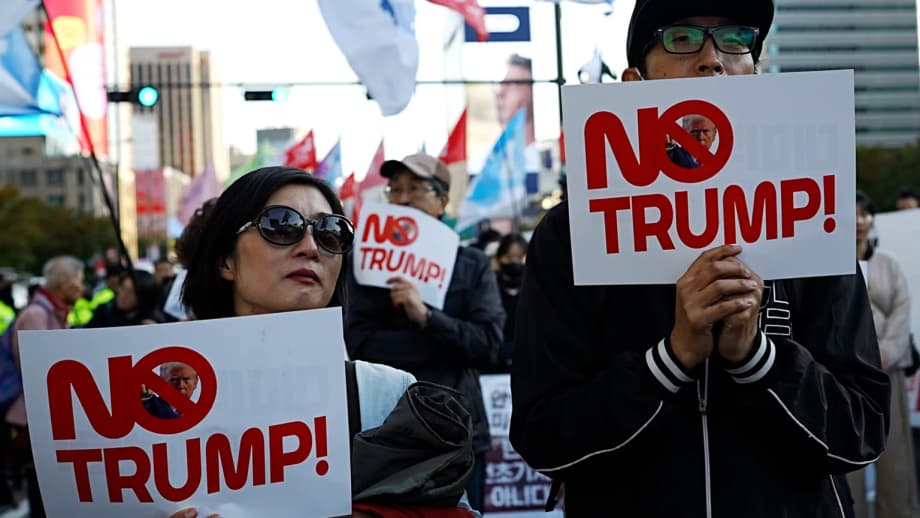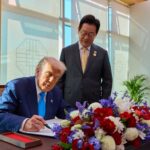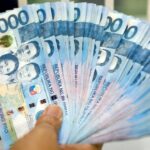A capital on edge as rival leaders arrive
Chants of “No Trump! No China!” rolled through central Seoul as protest groups converged near the United States embassy and by the gates of Gyeongbokgung palace. Police cordons held the lines, and the signs pointed in opposite directions: some aimed at Washington’s return to tariff brinkmanship, others at Beijing’s growing clout. The split-screen protests captured South Korea’s dilemma as it welcomes the leaders of the world’s two largest economies.
- A capital on edge as rival leaders arrive
- Why this summit matters for Seoul and beyond
- Balancing act no longer fits a neat split
- Beijing and Washington press their cases
- Xi and Trump meet while the host seeks room to maneuver
- North Korea’s shadow grows longer
- Economic stakes for South Korean companies
- How public opinion shapes the options
- The Bottom Line
For President Lee Jae Myung, the optics matter. South Korea depends on the US alliance for security, with roughly 28,500 American troops stationed on the peninsula, and it depends on China for growth as its largest trading partner. Public opinion reflects this bind. Many South Koreans still see the US as the indispensable ally, while unfavorable views of China have risen since the 2016 deployment of the US THAAD missile defense system and the economic retaliation that followed. Maritime run-ins over fishing in the Yellow Sea, and recurring cultural and historical disputes, have fed skepticism toward Beijing.
Lee has tried to lower the temperature at home. His government backs legislation to curb hate rallies while underscoring the right to protest, a signal that civil discourse should not tip into intimidation as foreign leaders gather. The aim is to project calm, reassure partners, and keep the focus on diplomacy rather than street theater.
Why this summit matters for Seoul and beyond
South Korea is hosting the Asia Pacific Economic Cooperation summit in the historic city of Gyeongju, the first time in two decades that APEC has convened on Korean soil. The timing magnifies the stakes. China’s president, Xi Jinping, is making his first trip to South Korea in 11 years. The American president, Donald Trump, is in the country as well, reviving a relationship that now spans tariffs, technology controls, and the future of US forces on the peninsula. President Lee plans separate one on one sessions with both leaders around the APEC schedule.
Seoul wants the gathering to produce more than photos. Officials are working toward a joint statement that organizers have nicknamed the Gyeongju Declaration, a nod to a similar bid that collapsed in 2018 when trade fights blocked consensus. The agenda is crowded: stabilizing supply chains, keeping advanced technology trade open where possible, and defusing the threat of new tariff shocks that could hit South Korean exporters. Lee also faces touchy issues tied to events abroad, including US immigration raids that swept up South Korean workers and the friction from recent tariff threats out of Washington.
Trade friction meets host diplomacy
The host government has been racing against the clock with Washington. The United States has sharpened its use of tariffs and export controls, and the White House has sought new concessions from trading partners in return for relief. Seoul has responded with a pragmatic approach. It has floated a multiyear package of investment in the United States valued in the hundreds of billions of dollars and discussed expanded US energy purchases, hoping to shield its carmakers, electronics firms, and shipbuilders from new penalties.
The pitch is straightforward. South Korea would keep deepening cooperation with the US on security and emerging technologies while keeping commercial channels with China open and predictable. Officials describe it as an exercise in damage control and risk reduction, not a pivot away from the alliance or a bet on Beijing. The message to both giants is that South Korea intends to be a reliable partner and a resilient economy, not a venue for proxy fights.
Balancing act no longer fits a neat split
For years, policymakers in Seoul repeated a simple formula, economy with China, security with the United States. That tidy split has unraveled. Technology and trade are now central to national defense, and security choices shape market access. US pressure on advanced chips and equipment has narrowed room for maneuver. Chinese countermeasures have grown sharper. The result is a tighter coupling of economic policy with alliance management.
Semiconductors, rare earths, and supply chain risks
South Korean champions sit at the heart of the technology contest. Samsung Electronics and SK Hynix supply memory chips that power data centers and smartphones around the world. China is a huge customer and a major production base for some of these firms. The United States, meanwhile, has tightened export rules on advanced chip gear to curb technology transfers to China. These crosscurrents create constant stress on Korean boardrooms and cabinet meetings alike.
Inputs matter as much as sales. South Korea depends on imports of critical minerals used in batteries and electronics, including rare earth elements that at times come almost entirely from Chinese suppliers. That reliance is a vulnerability if trade becomes a tool of pressure. Seoul is widening sourcing, striking deals with partners in Southeast Asia, Australia, and the Americas, while keeping lines open with Chinese producers to avoid sudden shortages.
Beijing and Washington press their cases
China’s diplomats have signaled that a reset is on offer. During talks with a visiting delegation from Seoul, Chinese Foreign Minister Wang Yi urged both sides to keep relations on the right track and to expand common interests. He framed the moment as a chance to improve sentiment between the two publics and to manage sensitive issues carefully.
Wang Yi said ties were at a critical juncture and called on both countries to uphold the direction of friendship, handle sensitive issues properly, and promote steady progress.
From Washington, the requests are different but equally pointed. The United States wants tighter coordination on North Korea deterrence, more active trilateral cooperation among South Korea, Japan, and the US, and support for regional Indo Pacific frameworks that counter coercive practices. In parallel, US officials have pushed for trade concessions and have floated changes to the American military footprint and cost sharing in South Korea. Seoul has kept disagreements behind closed doors, mindful that public clashes rarely help either side.
Xi and Trump meet while the host seeks room to maneuver
The summit within the summit came when Xi Jinping and Donald Trump sat down on the sidelines of the APEC gathering in South Korea. Their conversation was the first in person meeting since the US election put Trump back in the Oval Office. The session focused on tariffs, market access, and restoring channels for dialogue that had frayed in recent years. Officials on both sides described the exchange as constructive.
After the meeting, President Trump struck an upbeat tone about the talks, underscoring his desire for visible wins on trade while leaving room for follow up negotiations.
President Trump said the meeting was a great success and that both sides had made progress on trade issues.
For Xi, the trip carries a twin aim. He wants to steady a difficult relationship with Seoul and avoid deeper decoupling, while managing a complex rivalry with Washington. The APEC setting gives room for bilateral sessions and a larger conversation on growth at a time when Asia needs predictable rules and fewer shocks.
North Korea’s shadow grows longer
Strategic calculations around South Korea do not end at commerce. North Korea has tightened ties with Russia in the past year, raising fears that advanced military technology could flow to Pyongyang. That would alter risks for South Korea, Japan, and US forces in the region. China, the North’s traditional backer, is not entirely comfortable with a Moscow Pyongyang embrace that sidelines Beijing, yet it sees value when US allies feel pressure.
Seoul and Washington hope there is space to persuade Beijing to act as a brake, even if quietly. Meanwhile, President Trump has said he remains open to a future meeting with North Korean leader Kim Jong Un. South Korea says it is prepared for that possibility while focusing on practical steps at APEC. The country’s national security director described the host’s role as a mediator seeking a strong closing statement from the summit.
Wi Sung lac said many issues had been resolved and that the team was working toward a Gyeongju Declaration while acting as a bridge between the United States and China.
Economic stakes for South Korean companies
South Korean industry sits near the center of every negotiating table. China buys a large share of Korean exports, from chemicals to screens and machinery. The United States is a premium market for cars, batteries, and consumer electronics. A misstep with either can cost billions and jobs at home. This is why South Korean negotiators discuss tariff relief while also exploring new industrial collaboration with China on advanced batteries, high end displays, and clean energy supply chains.
What a reset with China could include
Officials on both sides have outlined familiar building blocks. High level meetings that are regular and predictable, practical working groups on supply chains and export controls, and an expansion of people to people ties through easier visas and more direct flights. Mechanisms to manage disputes, from fisheries in the Yellow Sea to standards in telecommunications, can reduce friction before it spills into headlines. Trilateral engagement with Japan and China, long stalled, is also back on the table in a limited form, giving Seoul another venue to keep conversations moving.
How public opinion shapes the options
Polls in recent years show a durable belief in the US alliance and a steep rise in negative views of China across age groups. Younger South Koreans, who consume news and culture across borders with ease, have been particularly skeptical of Beijing since the THAAD episode and a series of maritime disputes. That does not mean the public wants confrontation. It does mean that any overture to China must come with clear gains, and that US requests are still weighed against the country’s interests. President Lee’s answer has been to back pragmatic diplomacy and to call for respect in both directions, while moving to rein in protests that slide toward intimidation.
The Bottom Line
- Protesters in Seoul targeted both Washington and Beijing as South Korea welcomed rival leaders.
- APEC returned to South Korea for the first time in 20 years, with Xi Jinping visiting for the first time in 11 years.
- Xi and Trump met on the sidelines in South Korea and signaled progress on trade, with more negotiations ahead.
- Seoul is pushing for a Gyeongju Declaration to show unity on growth and rules after a failed effort in 2018.
- The old split of economy with China and security with the US has broken down as technology and trade now shape defense.
- Chinese officials called ties with South Korea a critical juncture, while the United States pressed for closer deterrence and trilateral work with Japan.
- North Korea’s growing closeness with Russia adds fresh risk and keeps China central to managing the peninsula.
- South Korean firms depend on both the US and China, so Seoul is seeking tariff relief, stable supply chains, and new cooperation without alienating either side.




